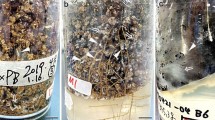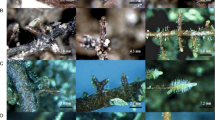Abstract
In vitro ectomycorrhizal synthesis of Tricholoma matsutake with host plants has been widely conducted to elucidate fungal symbiotic properties for future cultivation practices. Here, we report on the importance of basidiospore inocula for this fungus to provide ectomycorrhizal seedlings in vitro. Ectomycorrhizal pine seedlings synthesized in vitro with cultured mycelium of T. matsutake (isolate #45 or #84) in a 250-mL culture vessel (soil volume) were transplanted to a large 1-L culture vessel. Fresh basidiospores of this fungus were aseptically inoculated on the ectomycorrhizal root system. The ectomycorrhizal seedlings in the 1-L vessel were grown for 9 months, and some plants were further grown for 6 more months under non-aseptic conditions in 4.1-L jars. The ectomycorrhizal seedlings previously inoculated with isolate #84 in the 1-L vessel showed significant ectomycorrhizal biomass (mycorrhizal root length) after spore inoculation. The ectomycorrhizal seedlings in the 4.1-L vessel showed large shiro structures (> 10 cm in diameter). PCR amplification of intergenic spacer 1 of the rRNA gene and long terminal repeat retroelement of T. matsutake in ectomycorrhizal root tips in both the 1-L vessels and 4.1-L jars revealed the presence of amplicons of the previously inoculated culture isolate of T. matsutake and the new genet(s) that established via germination of the inoculated basidiospores. This is the first report that inoculated basidiospores of T. matsutake germinated and colonized the host root to generate ectomycorrhizae in vitro.




Similar content being viewed by others
References
Allen MF (1991) The ecology of mycorrhizae. Cambridge University Press, Cambridge
Arioka T (1997) Matsutake. Hosei University Press, Tokyo (In Japanese)
Brundrett M, Bougher N, Dell B, Grove T, Malajczuk N, (1996) Working with Mycorrhizas in Forestry and Agriculture. Australian Centre for InternationalAgricultural Research, Canberra.
Cairney JWG, Chambers SM (eds) (1999) Ectomycorrhizal fungi: Key genera in profile. Springer, Berlin
Cooke RC, Whipps JM (1993) Ecophysiology of Fungi. Wiley-Blackwell, Hoboken, NJ
Endo N, Dokmai P, Suwannasai N, Phosri C, Horimai Y, Hirai N, Masaki F, Yamada A (2015) Ectomycorrhization of Tricholoma matsutake with Abies veitchii and Tsuga diversifolia in the subalpine forests of Japan. Mycoscience 56:402–412. https://doi.org/10.1016/j.myc.2014.12.004
Fukuda M, Mori Y (2003) Genetic differences in wild strains of Lentinula edodes collected from a single fallen tree. Mycoscience 44:365–368. https://doi.org/10.1007/s10267-003-0127-y
Fukuda M, Mori Y, Yamada A (2007) Genetic variability among Pholiota aurivella isolates from a small natural population. Mycoscience 48:381–387. https://doi.org/10.1007/s10267-007-0381-5
Furukawa H, Masuno K, Takeuchi Y (2016) Forest management of matsutake productive sites for the optimization to global warming. Annu Rep Nagano Pref For Res Cent 30:87–100 ((In Japanese))
Gisusi S, Azuma T, Yoshida S, Yoneyama S, Harada A, Tsuda M, Tamai Y (2019) Investigation of soil environments in the vicinity of Tricholoma matsutake mycelium in Abies sachalinensis stand. Jpn J Mycol 60: 43–48 (In Japanese). https://doi.org/10.18962/jjom.jjom.H31-02
Guerin-Laguette A, Matsushita N, Kikuchi K, Iwase K, Lapeyrie F, Suzuki K (2002) Identification of a prevalent Tricholoma matsutake ribotype in Japan by rDNA IGS1 spacer characterization. Mycol Res 106:435–443. https://doi.org/10.1017/S0953756202005725
Guerin-Laguette A, Shindo K, Matsushita N, Suzuki K, Lapeyrie F (2004) The mycorrhizal fungus Tricholoma matsutake stimulates Pinus densiflora seedling growth in vitro. Mycorrhiza 14:397–400. https://doi.org/10.1007/s00572-004-0322-5
Hall I, Wang Y, Danell E, Zambonelli A (2002) Edible mycorrhizal mushrooms and their cultivation. Proceedings of the Second International Conference on Edible Mycorrhizal Mushrooms, Christchurch, New Zealand
Hamada M (1970) Diaries on Armillaria matsutake (5). Trans Mycol Soc Jpn 11:81–86 ((in Japanese))
Horimai Y, Misawa H, Suzuki K, Fukuda M, Furukawa H, Masuno K, Yamanaka T, Yamada A (2020) Sibling spore isolates of Tricholoma matsutake vary significantly in their ectomycorrhizal colonization abilities on pine hosts in vitro and form multiple intimate associations in single ectomycorrhizal roots. Fungal Ecol 43. https://doi.org/10.1016/j.funeco.2019.100874
Hosford D, Pilz D, Molina R, Amaranthus MP (1997) Ecology and management of the commercially harvested American matsutake mushroom. USDA For Serv Gen Tech Rep 1027 PNW-412, Portland, Ore
Ito T, Ogawa M (1979) Cultivation method of the mycorrhizal fungus, Tricholoma matsutake (Ito et Imai) Sing. (II) Increasing number of shiro (fungal colony) T. matsutake by thinning the understory vegetation. J Jpn For Soc 61: 163–173 (In Japanese). https://doi.org/10.11519/jjfs1953.61.5_163
Ka K-H, Kim H-S, Hur T-C, Park H, Jeon S-M, Ryoo R (2018) Analysis of environment and production of Tricholoma matsutake in matsutake-infected pine trees. Korean J Mycol 46:34–42. https://doi.org/10.4489/KJM.20180005
Kareki K, Kawakami Y (1985) Artificial formation of shiro (fungus colony) by planting the pine saplings infected with Tricholoma matsutake (Ito et Imai) Sing. Ann Rep Hiroshima Pref For Exp Sta 20:13–23 ((in Japanese))
Kobayashi H, Watahiki T, Kuramochi M, Onose K, Yamada A (2007) Production of pine seedlings with the shiro-like structure of the matsutake mushroom (Tricholoma matsutake (S. Ito et Imai) Sing.) in a large culture bottle. Mushroom Sci Biotechnol 15:151–155 ((in Japanese))
Kobayashi H, Terasaki M, Yamada A (2015) Two-year survival of Tricholoma matsutake ectomycorrhizas on Pinus densiflora seedlings after outplanting to a pine forest. Mushroom Sci Biotechnol 23: 108–113. https://doi.org/10.24465/msb.23.3_108
Lian C, Narimatsu N, Nara K, Hogetsu T (2006) Tricholoma matsutake in a natural Pinus densiflora forest: correspondence between above- and below-ground genets, association with multiple host trees and alteration of existing ectomycorrhizal communities. New Phytol 171:825–836. https://doi.org/10.1111/j.1469-8137.2006.01801.x
Matsushita N, Kikuchi K, Sasaki Y, Guerin-Laguette A, Vaario L-M, Suzuki K (2005) Genetic relationship of Tricholoma matsutake and T. nauseosum from the Northern Hemisphere based on analyses of ribosomal DNA spacer regions. Mycoscience 46:90–96. https://doi.org/10.1007/s10267-004-0220-x
Matsutake Research Association (1964) Matsutake (Tricholoma matsutake Singer)—its fundamental studies and economic production of the fruitbody. Matsutake Research Association, Kyoto (in Japanese)
Min B, Yoon H, Park J, Oh Y-L, Kong WS, Kim J-G, Choi I-G (2020) Unusual genome expansion and transcription suppression in ectomycorrhizal Tricholoma matsutake by insertions of transposable elements. PLoS One 15(1):e0227923. https://doi.org/10.1371/journal.pone.0227923
Murata H, Babasaki K, Yamada A (2005a) Highly polymorphic DNA markers to specify strains of the ectomycorrhizal basidiomycete Tricholoma matsutake based on σmarY1, the long terminal repeat of gypsy-type retroelement marY1. Mycorrhiza 15:179–186. https://doi.org/10.1007/s00572-004-0319-0
Murata H, Ohta A, Yamada A, Narimatsu M, Futamura N (2005b) Genetic mosaics in the massive persisting rhizosphere colony “shiro” of the ectomycorrhizal basidiomycete Tricholoma matsutake. Mycorrhiza 15:505–512. https://doi.org/10.1007/s00572-005-0358-1
Murata H, Ota Y, Yamaguchi M, Yamada A, Katahata S, Otsuka Y, Babasaki K, Neda H (2013) Mobile DNA distributions refine the phylogeny of “matsutake” mushrooms. Tricholoma sect. Caligata. Mycorrhiza 23:447–461. https://doi.org/10.1007/s00572-013-0487-x
Murata H, Ohta A, Yamada A, Horimai Y, Katahata S, Yamaguchi M, Neda H (2015) Monokaryotic hyphae germinated from a single spore of the ectomycorrhizal basidiomycete Tricholoma matsutake. Mycoscience 56:287–292. https://doi.org/10.1016/j.myc.2014.08.004
Narimatsu M, Koiwa T, Masaki T, Sakamoto Y, Ohmori H, Tawaraya K (2015) Relationship between climate, expansion rate, and fruiting in fairy rings (‘shiro’) of an ectomycorrhizal fungus Tricholoma matsutake in a Pinus densiflora forest. Fungal Ecol 15:18–28. https://doi.org/10.1016/j.funeco.2015.02.001
Narimatsu M, Koiwa T, Sakamoto Y, Natsume S, Kurokochi H, Lian C, Nakajima Y, Nakade K, Yoshida K, Tawaraya K (2016) Estimation of novel colony establishment and persistence of the ectomycorrhizal basidiomycete Tricholoma matsutake in a Pinus densiflora forest. Fungal Ecol 24:35–43. https://doi.org/10.1016/j.funeco.2016.08.001
Ogawa M (1978) The biology of matsutake. Tsukiji-shokan, Tokyo (In Japanese)
Ogawa M, Umehara T, Kontani S, Yamaji K (1978) Cultivation method of the mycorrhizal fungus, Tricholoma matsutake (Ito et Imai) Sing. (I) Growing method of the saplings infected with T. matsutake in the field. J Jpn For Soc 60: 119–128 (In Japanese). https://doi.org/10.11519/jjfs1953.60.4_119
Ogawa M, Ito T, Kobayashi F, Fujita H (1980) On the primary stage of “shiro” formation of Tricholoma matsutake. Trans Mycol Soc Jpn 21:505–512 ((In Japanese))
Ohta A (1988) Effects of butyric acid and related compounds on basidiospore germination of some mycorrhizal fungi. Trans Mycol Soc Jpn 29: 375–381
Park H, Ka K-H (2010) Spore dispersion of Tricholoma matsutake at a Pinus densiflora stand in Korea. Mycobiology 38:203–205. https://doi.org/10.4489/MYCO.2010.38.3.203
Raper JR (1966) Genetics of sexuality in higher fungi. The Ronald Press Company, New York
Saito C, Ogawa W, Kobayashi H, Yamanaka T, Fukuda M, Yamada A (2018) In vitro ectomycorrhization of Tricholoma matsutake strains is differentially affected by soil type. Mycoscience 59:89–97. https://doi.org/10.1016/j.myc.2017.09.002
Smith SE, Read DJ (2008) Mycorrhizal symbiosis, 3rd edn. Academic Press, Amsterdam
Stenlid J (2008) Population biology of forest decomposer basidiomycetes. In: Boddy L, Frankland J, van West P (eds), Ecology of saprotrophic basidiomycetes. Academic Press, London, pp 105–122. https://doi.org/10.1016/S0275-0287(08)80008-2
Vaario L-M, Yang X, Yamada A (2017) Biogeography of the Japanese gourmet fungus, Tricholoma matsutake: a review of the distribution and functional ecology of Matsutake. In: Tedersoo, L. (ed.), Biogeography of Mycorrhizal Symbiosis. Ecological Studies (Analysis and Synthesis), vol. 230. Springer, Cham, pp. 319–344. https://doi.org/10.1007/978-3-319-56363-3_15
Yamada A, Katsuya K (1995) Mycorrhizal association of isolates from sporocarps and ectomycorrhizas with Pinus densiflora seedlings. Mycoscience 36:315–323. https://doi.org/10.1007/BF02268607
Yamada A, Kanekawa S, Ohmasa M (1999) Ectomycorrhiza formation of Tricholoma matsutake on Pinus densiflora. Mycoscience 40:193–198. https://doi.org/10.1007/BF02464298
Yamada A, Ogura T, Degawa Y, Ohmasa M (2001) Isolation of Tricholoma matsutake and T. bakamatsutake cultures from field-collected ectomycorrhizas. Mycoscience 42:43–50. https://doi.org/10.1007/BF02463974
Yamada A, Maeda K, Kobayashi H, Murata H (2006) Ectomycorrhizal symbiosis in vitro between Tricholoma matsutake and Pinus densiflora seedlings that resembles naturally occurring ‘shiro.’ Mycorrhiza 16:111–116. https://doi.org/10.1007/s00572-005-0021-x
Yamada A, Kobayashi H, Murata H, Kalmis E, Kalyoncu F, Fukuda M (2010) In vitro ectomycorrhizal specificity between the Asian red pine Pinus densiflora and Tricholoma matsutake and allied species from worldwide Pinaceae and Fagaceae forests. Mycorrhiza 20:333–339. https://doi.org/10.1007/s00572-009-0286-6
Yamada A, Endo N, Murata H, Ohta A, Fukuda M (2014) Tricholoma matsutake Y1 strain associated with Pinus densiflora shows a gradient of in vitro ectomycorrhizal specificity with Pinaceae and oak hosts. Mycoscience 55:27–34. https://doi.org/10.1016/j.myc.2013.05.004
Yamada A, Hayakawa N, Saito C, Horimai Y, Misawa H, Yamanaka T, Fukuda M (2019) Physiological variation among Tricholoma matsutake isolates generated from basidiospores obtained from one basidioma. Mycoscience 60:102–109. https://doi.org/10.1016/j.myc.2018.12.001
Yamanaka T, Ota Y, Yamazaki M, Kawai M, Ohta A, Neda H, Terashima Y, Yamada A (2014) The host ranges of conifer-associated Tricholoma matsutake, Fagaceae-associated T. bakamatsutake and T. fulvocastaneum are wider in vitro than in nature. Mycologia 106:397–406. https://doi.org/10.3852/13-197
Yamanaka T, Yamada A, Furukawa H (2020) Researches for the cultivation of Tricholoma matsutake, a highly-prized ectomycorrhizal mushroom. Mycoscience 61:49–57. https://doi.org/10.1016/j.myc.2020.01.001
Zambonelli A, Iotti M, Murat C (eds.) (2016) True truffle (Tuber spp.) in the world. Springer, Cham
Acknowledgements
We acknowledge Masamichi Ichikawa for the supply of fresh Tricholoma matsutake samples in the spore inoculation experiment, and Hitoshi Murata in Forestry and Forest Products Research Institute for the technical advice in DNA analyses. We thank the members of Applied Mycology Laboratory, Shinshu University for their support of this study.
Funding
This study was supported in part by KAKENHI Grant Number 15H01751 from the Japan Society for the Promotion of Science (JSPS), and a grant from the Ministry of Agriculture, Forestry and Fisheries of Japan, “Technology development for the optimal use of forest resources.”
Author information
Authors and Affiliations
Corresponding author
Additional information
Publisher's Note
Springer Nature remains neutral with regard to jurisdictional claims in published maps and institutional affiliations.
Supplementary Information
Below is the link to the electronic supplementary material.
Rights and permissions
About this article
Cite this article
Horimai, Y., Misawa, H., Suzuki, K. et al. Spore germination and ectomycorrhizae formation of Tricholoma matsutake on pine root systems with previously established ectomycorrhizae from a dikaryotic mycelial isolate of T. matsutake. Mycorrhiza 31, 335–347 (2021). https://doi.org/10.1007/s00572-021-01028-3
Received:
Accepted:
Published:
Issue Date:
DOI: https://doi.org/10.1007/s00572-021-01028-3




